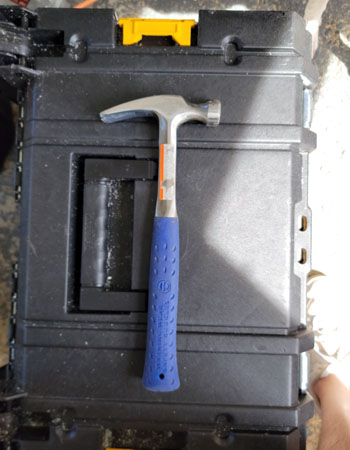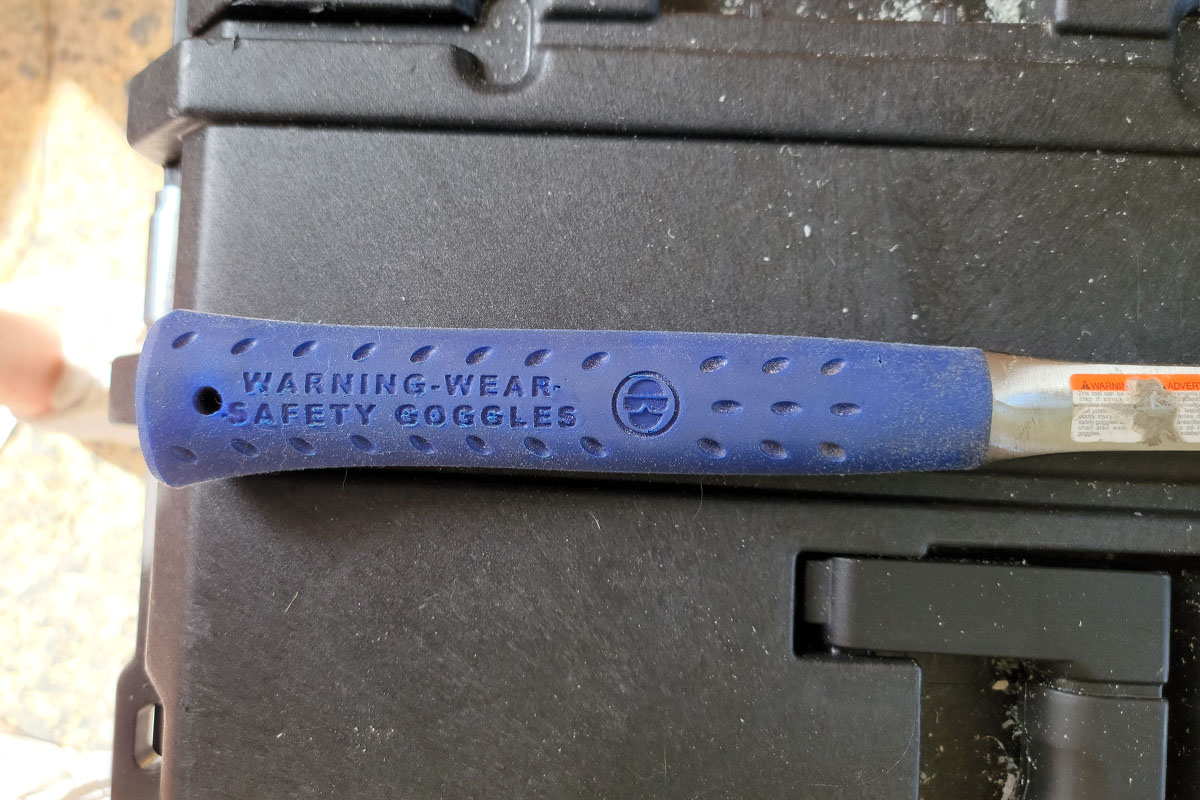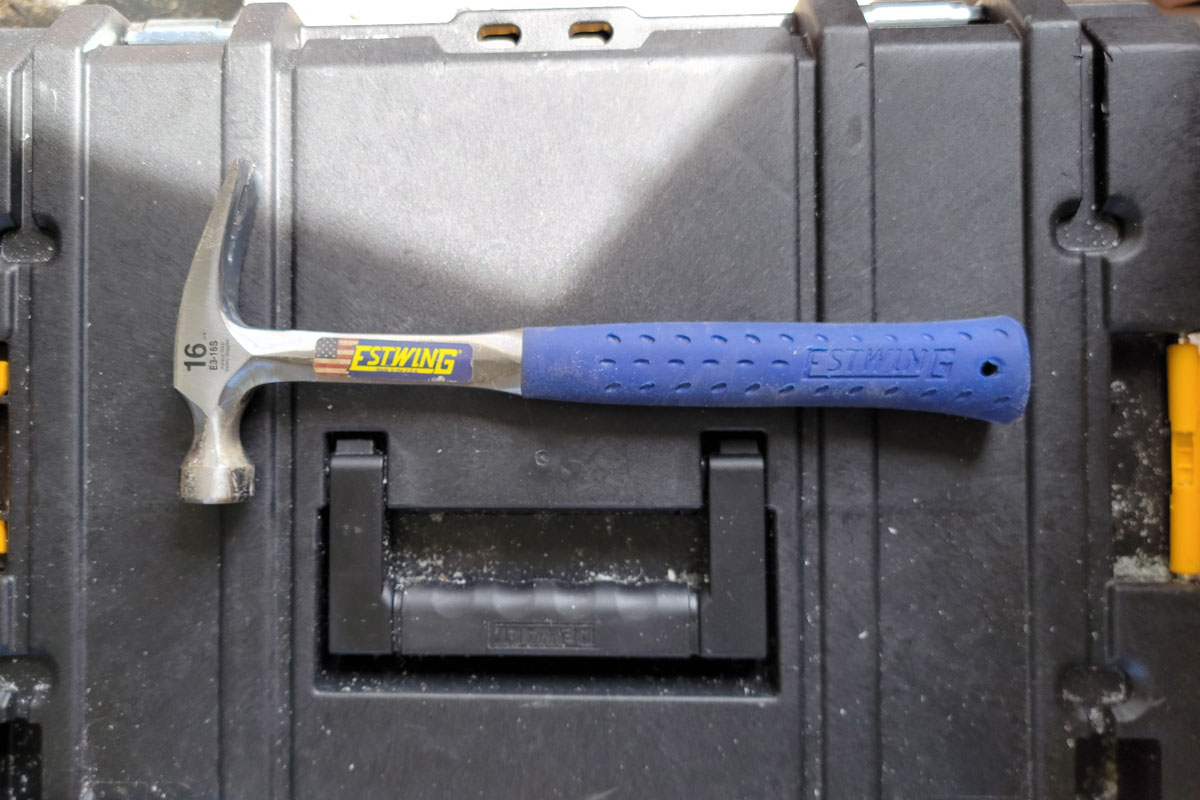We may earn revenue from the products available on this page and participate in affiliate programs. Learn More ›
I spent many years leaning on my tools to make a living. No, I don’t mean leaning against a shovel or workbench while everyone else was working. I mean relying on these tools to do what they were supposed to do. They needed to work, or I couldn’t do my job. One of the brands I learned to rely on was Estwing.
Estwing makes striking tools—and high-quality ones at that. You’ll find the brand’s framing hammers, rubber mallets, roofing hatchets, drywall hatchets, sledgehammers, and other striking tools on just about any job site. And the reason is, tradespeople respect them for their reliability and build quality. But is it all hype?
I got my hands on a brand-new Estwing hammer and compared it to other brands to find out. I wanted to find out if the make of the hammer matters and if this hammer is really all it’s cracked up to be. Keep reading to find out what my thoughts are and to see if this is the best hammer for you.
Estwing Hammer: At a Glance

Rating: 9/10
PROS
- Solid, one-piece steel
- Excellent shock-absorbing grip
- Unbeatable nail pulling comfort
CONS
- Heavier than other 20-ounce models
Get the Estwing Hammer at:
What Is the Estwing Hammer?
The Estwing hammer is a one-piece, all-steel hammer. The shank (or handle) runs from the head of the tool to the base of the grip. The grip that surrounds it is a durable rubber material that absorbs shock for all-day use.
The face of the Estwing hammer (the part that strikes the nail) is smooth and round, so it’s suitable for general purposes like framing, finish work, or even drywall. The claws (the part that removes the nail) are straight, making them useful for getting underneath stubborn nails but also for separating framing lumber, prying apart items, and other general uses.
The Estwing hammer measures 13.75 inches from the base of the handle to the head, and the head itself weighs 20 ounces. The size and weight lend themselves well to general use, as the hammer is heavy enough to drive a framing nail but light and short enough to control for finish work.
If you haven’t picked up on it yet, the Estwing hammer is a general-purpose, all-around hammer. Estwing does make other hammers specifically for framing or light-duty work, but this model is the catch-all that covers every base.

How Easy Is the Estwing Hammer to Use?
Like any hammer, how easy the Estwing Hammer is to use will depend on the user. For those without a lot of upper body strength or who have weaker wrists, a 20-ounce hammer could be too much. But for most people, it might be ideal.
Sixteen and 20-ounce hammers are considered the industry standard for do-all hammers. The lighter models are a little more difficult to drive a framing nail with, while the heavier models (like the one I tested) could be a bit more challenging in awkward positions or for striking tiny finish nails. Both can do either job, but it takes practice.
When it comes to removing nails or prying apart items, the Estwing hammer is outstanding. The straight claw versus curved claw debate will continue as long as tradespeople use hammers, but I prefer the straight claw, and for that, the Estwing is superior. I can drive it into a piece of framing lumber instead of bending over to pick it up off the deck, but I can also wedge it between two boards nailed together to pry them apart. It’s difficult to do either with a curved claw hammer.
That said, curved claws are easier to use in tight spaces, such as stud bays and cabinets, but it’s really a matter of preference and learning to use the tool.
How Comfortable Is the Estwing Hammer to Use?
If there’s an area where the Estwing hammer truly excels, it’s comfort. This hammer is the perfect blend of power and cushioning, making all-day use bearable.
The Estwing hammer is not a new design. The company has been manufacturing this model for generations, and if you look at older models (there are still plenty around), the blue rubber handles are shiny and quite hard. The newer Estwing hammers use a much better thick and heavily cushioned rubber design, allowing for much better shock reduction.
Shock reduction is obviously important for driving nails. All-steel hammers are notoriously bad at this task, which is why so many carpenters use wooden-handled hammers. However, the Estwing hammer’s shock reduction is excellent. I drove many nails with this hammer, and it was more comfortable than any other hammer I tested.
Shock reduction is also important for removing nails. There are times when it’s just not possible to get the leverage required to remove a nail by pulling, and the only answer is smacking the handle of the hammer with an open palm a few times. Without the Estwing’s rubber grip, this can hurt. Luckily, it’s a breeze with the Estwing hammer.
Is the Estwing Hammer Good Quality?
I previously mentioned finding older Estwing hammer models with the hardened rubber grips and alluded to the fact that there are plenty left. The reason for that is these hammers are unbelievably durable and of high quality. Estwing makes these hammers from one piece of forged steel, which makes them very tough and robust. The neck of the hammer won’t bend, and the claws won’t deform.
Will the face deform over time? Yes, probably. If you strike enough 16d framing nails with this hammer, scratches and chips will probably occur. But for the average DIYer, this is a long, long way off. And deforming is normal for any hammer other than titanium models.
Older models did have issues with the rubber grip hardening, but the newer shock-absorbing grips don’t suffer the same fate. The rubber remains soft and continues to absorb shock for years.
And this hammer doesn’t require much maintenance. The polished steel is rust resistant, and the grips rarely slip or separate. There also isn’t a wooden handle that can split, crack, or shrink. Essentially, this could be the last general-purpose hammer a DIYer ever has to buy.

Is the Estwing Hammer Worth the Money?
I’m a big fan of this hammer. I was already pretty familiar with the brand, but I drove a bunch of nails, pried with the claws, and used it for general work for weeks. The question is: For just under $30, is the Estwing hammer a good deal?
Consider this: A typical 20-ounce hammer will cost roughly $20 to $25. All-steel models typically feature hard rubber handles, and they do a terrible job of absorbing shock. Fiberglass handles are excellent at absorbing shock, but they’re not as durable for prying. Wooden handles eventually crack, split, chip, splinter, shrink, or break. If you have to replace the handle, it will cost $5 to $8. If you have to replace the hammer, you’re out another $20 to $25.
None of that will happen with the Estwing hammer. The handle won’t come loose, and the grip stays soft for years to come. There are less expensive and more expensive hammers on the market (I own many of them), but none of them will outlast an Estwing hammer. So yes, the Estwing hammer is absolutely worth the money.
Is the Estwing Hammer Right for You?
When I test a product, I like to think about who would want it or benefit from it. The idea is to use the tool, assess its strengths, and think long and hard about a few types of people who could use it. I usually come up with three or four types of people and explain why the product would be ideal for them.
That’s not the case this time with the Estwing hammer—a definitive answer is probably all that’s necessary.
If you need a new hammer, seriously consider the Estwing hammer. Between its quality, durability, and shock absorption, it’s legitimately one of the best hammers on the market. This hammer is capable of almost any job, and there’s a reason so many tradespeople rely on it: dependability.
If there’s one area that might deter someone from the Estwing hammer, it might be the weight. Yes, the head of the hammer is 20 ounces, but the all-steel shank and thick rubber grip add a bit of heft that you won’t experience with a fiberglass or wood-handled hammer. So if you lack a bit of wrist strength, you can either use the Estwing hammer to build up that strength or shop for another hammer that isn’t as heavy.
For everyone else, this could be the last general-purpose hammer you ever buy, so give it some consideration.
Where to Buy the Estwing Hammer
Get the Estwing Hammer at:


